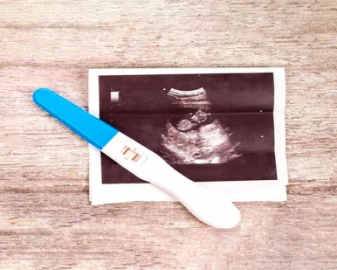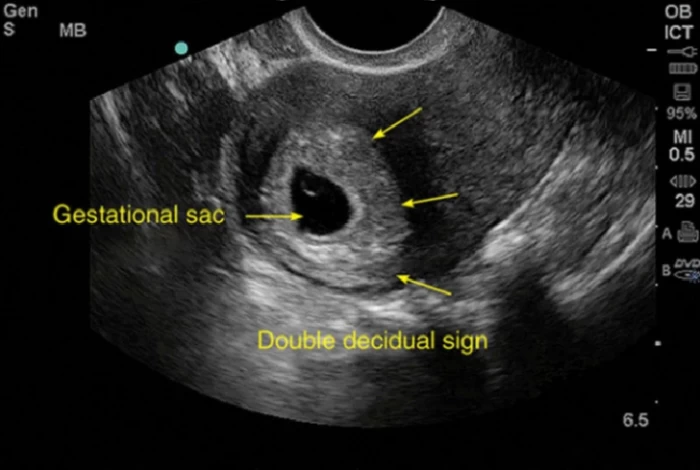Empty Sac in Pregnancy: Signs You Should Never Ignore
Fertility Treatment
An anembryonic pregnancy, also known as a blighted ovum, is a type of miscarriage that occurs when a fertilized egg implants in the uterus but fails to develop into an embryo. Instead, the placenta grows abnormally, forming a mass of cysts. Despite the absence of an embryo, the placenta continues to produce the hormone human chorionic gonadotropin (HCG), resulting in positive pregnancy test results. However, an ultrasound will reveal an empty gestational sac without an embryo.
During an anembryonic pregnancy, the gestational sac and placenta continue to develop, but the embryo does not form within the sac. This condition typically leads to a miscarriage in the first trimester of pregnancy. In most cases, the mother's body may detect chromosomal abnormalities in the fertilized egg and naturally miscarry.
A blighted ovum can sometimes present with no symptoms and may only be detected during a routine ultrasound. However, some women may experience blighted ovum symptoms such as severe nausea and vomiting, particularly those with a history of miscarriage or anembryonic pregnancy and women over 40 years old.
In this article, we will explore the causes and symptoms of anembryonic pregnancy, as well as the risk factors associated with this condition.

What Is an Anembryonic Pregnancy, and How Does It Occur?
When a sperm fertilizes an egg, the resulting embryo should begin to develop and grow. However, in an anembryonic pregnancy, this process is disrupted, and the embryo fails to form. Despite the absence of an embryo, the placenta continues to grow and produce the hormone human chorionic gonadotropin (hCG), leading to positive pregnancy test results.
Blighted ovum commonly occurs in the first trimester of pregnancy and is characterized by the absence of a developing embryo within the gestational sac. An ultrasound is often the only way to detect an empty gestational sac. While relatively rare, blighted ovum accounts for approximately 50% of all first-trimester miscarriages, according to the American Pregnancy Association. This statistic underscores the significant impact of blighted ovum on early pregnancy loss.
The placenta continues to grow without the embryo, causing the pregnancy hormone levels to rise, making the mother feel pregnant. However, the mother's body usually recognizes that there is a problem and miscarries the empty gestational sac. This process is often referred to as a "silent miscarriage" because there may be no symptoms of a miscarriage, such as bleeding or cramping.
As the growth of the placenta stops and hormonal levels decrease, pregnancy symptoms also lessen. In such cases, women may experience mild cramping, spotting, and light bleeding. Can an empty sac still have a baby? This question often arises in discussions about early pregnancies. While it may seem perplexing, the term "empty sac" typically refers to a condition known as a blighted ovum, where an embryo fails to develop or is reabsorbed, leaving behind an empty gestational sac. Unfortunately, in such cases, the sac cannot produce a viable fetus.
It's important to note that the gestational sac is a fluid-filled structure that develops in the uterus early in pregnancy. It surrounds the embryo and provides a protective environment for its growth and development.
What Are the Symptoms of a Blighted Ovum?
Even though a blighted ovum may present with signs and symptoms resembling a normal pregnancy, it may also have specific symptoms that can vary in severity from patient to patient.
These blighted ovum symptoms may include:
- Severe nausea and vomiting;
- Dark or light brown vaginal bleeding within the first three months of pregnancy;
- Pelvic and lower abdominal cramping and pain (rare);
- Absence of fetal heartbeat;
- Thyroid disease such as hyperthyroidism;
- High levels of HCG hormone;
- High blood pressure or primary preeclampsia
- High protein levels in urine after the 20th week;
- Anemia;
- Ovarian cysts;
- Rapid and excessive growth of the uterus;
- Grape-like cysts Coming out of the vagina;
- Pregnancy poisoning (preeclampsia).

Does the Beta HCG Level Rise with a Blighted Ovum?
In a normal pregnancy, the beta hCG level increases as expected. With a blighted ovum, the beta hCG level can continue to rise because the placenta may grow quickly, even though there is no embryo. This phenomenon is often referred to as blighted ovum hCG, where the hormone levels can deceive, suggesting a viable pregnancy when there isn't one. For this reason, an ultrasound test is typically needed to diagnose a blighted ovum - and to confirm that the pregnancy sac is empty.
When Do the Symptoms of a Blighted Ovum Begin?
The symptoms of a Blighted Ovum may usually be visible between the 8th and 13th weeks of pregnancy. It is often identified by an ultrasound, which employs sound waves to examine the placenta and observe the empty sac pregnancy on the sonogram screen.
To diagnose an anembryonic pregnancy, the doctor will perform an ultrasound to determine the empty gestational sac with no sign of an embryo at 6 to 8 weeks of pregnancy. However, the confirmation of a blighted ovum depends on accurate calculation of the pregnancy age and conducting an ultrasound after the 5th week. If not, the doctor will schedule a follow-up ultrasound in one to two weeks.
Typically, the fetal heartbeat can be heard at week 8 of pregnancy, so the absence of fetal heartbeat confirms an anembryonic pregnancy.
What Causes an Anembryonic Pregnancy?
The exact cause of a blighted ovum is not always clear, but several factors may contribute to this condition:
Blighted ovum miscarriages are primarily caused by issues with chromosomes, the structures that carry genes. In this case, the mother’s body stops the pregnancy as it recognizes these abnormalities.
A blighted ovum can also result from a low-quality sperm or egg or abnormaIn this case, the body continues to release hCG and fails to detect the empty gestational sac. Unfortunately, this can happen to anyone, even the mothers with no history of miscarriage.
While blighted ovum can occur in any pregnancy, certain risk factors may increase the likelihood. This underscores the importance of understanding potential risk factors and seeking appropriate medical care and support for individuals with these predisposing conditions.
The common causes of an Anembryonic Pregnancy are:
- Previous miscarriage;
- A history of blighted ovum;
- Advanced maternal age, particularly being over 40 years old;
- family history of genetic disorders;
- Manganese superoxide dismutase (MnSOD) gene.
- polycystic ovary syndrome (PCOS);
- thyroid disorders.

How to Diagnose an Anembryonic Pregnancy?
An ultrasound is the primary method for diagnosing an anembryonic pregnancy that is typically performed between 6-9 weeks of gestation to visualize the contents of the uterus.
During an ultrasound, the size of the gestational sac is measured. If the diameter of the sac is greater than 20 mm, but no fetus is visible inside it, this indicates that an anembryonic pregnancy has occurred. If the diameter of the gestational sac measures less than 20 mm during an ultrasound, it indicates it is still early in the pregnancy. In this case, the ultrasound should be repeated after two weeks to allow for further embryo development and to confirm a viable pregnancy.
How long can you carry a blighted ovum? This question often troubles those facing the diagnosis. Typically, a blighted ovum is diagnosed through ultrasound around 8 to 10 weeks into the pregnancy, as the absence of fetal development becomes apparent despite a normally developing gestational sac. However, the duration a woman carries a blighted ovum can vary, as the body may not immediately recognize the absence of fetal development. In some cases, the body might naturally miscarry the blighted ovum, while in others, medical intervention may be necessary to prevent complications.
It is also worth mentioning that after the confirmation of an anembryonic pregnancy, the doctor may also conduct examinations for conditions like hyperthyroidism, preeclampsia, and anemia.
Missed Abortion in Blighted Ovum Cases
A missed abortion, also known as a silent miscarriage, can occur in cases of blighted ovum. the diagnosis is made during routine prenatal ultrasounds, where the absence of fetal development is observed.
What Is the Difference Between Anembryonic Pregnancy vs Molar Pregnancy?
The key differences between anembryonic pregnancy and molar pregnancy lie in their abnormal development, underlying causes, and aftercare. Anembryonic pregnancy pertains to a situation where the gestational sac does not contain an embryo. At the same time, molar pregnancy (also called Hydatiform mole or HM) involves anomalous growth of placental tissue, with or without abnormal fetal development.
In addition, it is recommended to use contraception for three months after an anembryonic pregnancy before trying to conceive again. However, in the case of a miscarriage due to a molar pregnancy, continuous medical monitoring is necessary for an extended period, and the interval before attempting another pregnancy will be substantially longer.
What Size Is the Anembryonic Gestational Sac?
By the 6th week of a typical pregnancy, the fetus becomes visible inside the gestational sac, measuring around 18mm in diameter. However, in a blighted ovum, the gestational sac develops normally, but the embryo does not form or stops developing very early. Therefore, the ultrasound will confirm the blighted ovum if the gestational sac diameter is 4 mm but without an embryo inside. This disparity in blighted ovum size compared to a progressing pregnancy is a crucial indicator for diagnosis.
Ultrasound is typically used to measure the diameter of the gestational sac.
- A pregnancy is anembryonic if a transvaginal ultrasound reveals a sac with a mean gestational sac diameter (MGD) of more than 25 mm and no yolk sac;
- Pregnancy is early if a transvaginal ultrasound reveals a sac with a mean gestational sac diameter (MGD) less than 25 mm. In this case, the ultrasound should be repeated in one to two weeks.

How Is a Blighted Ovum Removed?
In the case of an anembryonic pregnancy, the decision of whether to have a dilation and curettage (D&C) or wait for a natural miscarriage depends on individual circumstances.
During an ultrasound, the size of the pregnancy sac is measured, and the presence of an embryo or yolk sac is checked. If the sac is larger than 20 mm but there is no embryo, it is diagnosed as an anembryonic pregnancy. It is important to examine the entire sac using a vaginal ultrasound thoroughly.
The pregnancy has not progressed significantly if the sac is smaller than 20 mm. In such cases, a follow-up ultrasound is typically scheduled for two weeks later. An anembryonic pregnancy eventually leads to a miscarriage.
The body will naturally expel the pregnancy tissue when hormone levels decrease. However, this process may take several weeks. Medication or a D&C procedure may be used to remove the placenta in certain situations.
It is important to note that D&C is not usually recommended for a first pregnancy, as the body is capable of naturally eliminating the fetal tissue. The use of D&C is typically only necessary if the individual wants to conduct a tissue pathology test to investigate the cause of the miscarriage.

How to Prevent an Anembryonic Pregnancy?
Unfortunately, there is no guaranteed way to prevent an anembryonic pregnancy. This type of miscarriage rarely occurs more than once. When the miscarriage happens, menstruation resumes and the individual can attempt to conceive again.
However, it is advisable to wait for at least 12 menstrual cycles before attempting a second pregnancy, allowing the body adequate time to recover. In the case of recurrent pregnancy loss, it is essential to consult a gynecologist to detect the underlying cause. Moreover, undergoing genetic testing before pregnancy can help reduce the risk of a blighted ovum.
Final Word
Anembryonic pregnancy, also known as a blighted ovum, is a condition wherein a fertilized egg implants in the uterus but fails to develop an embryo. Although this condition can be emotionally devastating for expectant parents, understanding the causes, symptoms, and treatment options can help mitigate the anxiety and provide necessary support.
Early detection through ultrasound and hormonal monitoring is crucial for accurate diagnosis, allowing doctors to determine the most appropriate course of action. However, it's important to remember that a blighted ovum diagnosis does not necessarily mean the end of the journey. Many individuals have gone on to experience successful pregnancies after blighted ovums, offering hope and encouragement amidst the challenges.
Frequently Asked Questions about a Blighted Ovum
How long can you carry a blighted ovum?
Most blighted ovums are naturally miscarried within the first trimester, usually between 6 and 12 weeks. In some cases, it may remain undetected a little longer, but carrying it beyond the first trimester is rare and can increase complications. Early medical evaluation is recommended if suspected.
What are the hCG levels in a blighted ovum?
hCG levels in a blighted ovum typically rise slower than in a normal pregnancy. They may plateau or increase inconsistently, indicating the embryo hasn’t developed. Serial blood tests are crucial for accurate diagnosis.
How do I know if my pregnancy is anembryonic?
An anembryonic pregnancy, or blighted ovum, is usually diagnosed via ultrasound when a gestational sac forms but no embryo is visible. Common signs include mild cramping or early pregnancy bleeding, though some women feel no symptoms at all.
Why is there no embryo in an anembryonic pregnancy?
This occurs when the fertilized egg implants in the uterus but the embryo stops developing very early. The exact cause isn’t always known, but chromosomal abnormalities in the embryo are the most common reason.
Who is at a higher risk of experiencing anembryonic pregnancy?
Women over 35, those with a history of recurrent miscarriages, or individuals with certain medical conditions like uncontrolled diabetes may face a higher risk. Lifestyle factors and genetic issues can also contribute.
Is it possible to get pregnant after an anembryonic pregnancy?
Yes. Most women can conceive again normally after a blighted ovum. Doctors typically recommend a brief recovery period before trying, often one or two menstrual cycles.
Can an anembryonic pregnancy be successful?
No. A blighted ovum cannot develop into a viable pregnancy because the embryo never forms. Early detection allows safe management, either naturally or medically.
Is it possible to experience recurrent blighted ovum?
Recurrent cases are rare but can happen. Genetic counseling, fertility evaluation, and addressing underlying health issues can reduce recurrence risk.
At what stage does a blighted ovum usually miscarry?
Most miscarriages occur within the first trimester, typically between 6 and 12 weeks. Some cases may last slightly longer, but carrying beyond the first trimester is uncommon.
What is an empty gestational sac?
An empty gestational sac is the fluid-filled structure seen in early pregnancy ultrasounds without an embryo inside. It’s the hallmark of a blighted ovum and usually indicates early pregnancy loss.









User
-In the case of twins and where one sac is empty, can it affect the other twin ?
فاطمه وجهی
-Not really, each sac grows independently and does not affect the other
User
-Is there medicine to help prevent blighted ovum?
فاطمه وجهی
-Dear user,
blighted ovum happens due to several reasons. usually people with unhealthy habits like smoking/drinking or not having enough servings of vitamins and minerals tend to have blighted ovum more often. however, this is not the only reason. Genetics can also be a reason.
therefore, have a blood test, (LH,FSH, and AMH) and ultrasound to see if you can find where the problem comes from. Hopefully in order to have a positive result.